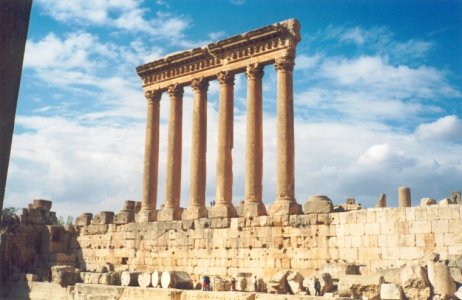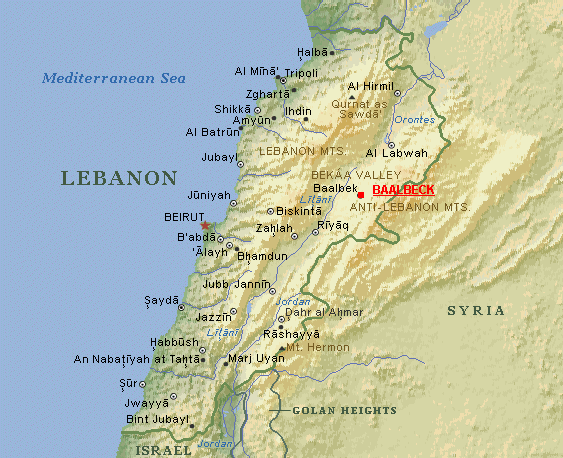Travels - > Middle East - > Syria & Lebanon - > Baalbeck
BAALBECK
(Lebanon)

Baalbek (ancient Heliopolis), town, eastern Lebanon, between the Litani and Asi rivers. The name, which means “City of Baal,” is derived from the early association of the town with the worship of Baal, a local sun deity whom the ancient Greeks identified with their sun god, Helios; the Greeks and Romans called the town Heliopolis, “City of the Sun.” Once a splendid city, it is famous now for the imposing ruins of ancient temples.
The great Temple of the Sun was about 49 by 88 m (about 160 by 290 ft) and contained 58 Corinthian columns, each 22.9 m (75 ft) high and 2.2 m (7.25 ft) in diameter. The entablature was 4.3 m (14 ft) in height. The temple appears to have been built on an artificial mound of earth, with great stones, or megaliths, employed to sustain this mass. Of these megaliths, three are in position at the western end, one of them measuring 19.5 m (64 ft) long by 4.3 m (14 ft) square. The Temple of Jupiter, also of the Corinthian order, measured 69.2 m (227 ft) by 35.7 m (117 ft) and was surrounded by a peristyle of 42 plain columns, with 10 fluted columns in the vestibule. The entablature was very profusely and richly ornamented. The Temple of Bacchus, in front of the Temple of Jupiter, is better preserved. A smaller temple, the Temple of Venus, supported by six granite columns, adjoined the Temple of Jupiter. Traces also remain of a later Christian basilica.
Although the early history of Baalbek is almost entirely unknown, abundant evidence indicates that the city is ancient, portions of the masonry being attributed to Phoenician origin. The Roman emperor Augustus made the city a Roman colony; the Roman emperor Trajan consulted a celebrated oracle there. The city was sacked by the Arabs in AD748, and pillaged by the Turkic chieftain Tamerlane in 1400. A severe earthquake in 1759 devastated what monuments still remained in the city. Present-day Baalbek, connected by rail with Beirut and with Damascus and Halab (Aleppo) in Syria, is the chief town in eastern Lebanon. Population (1981 estimate) 50,000.
